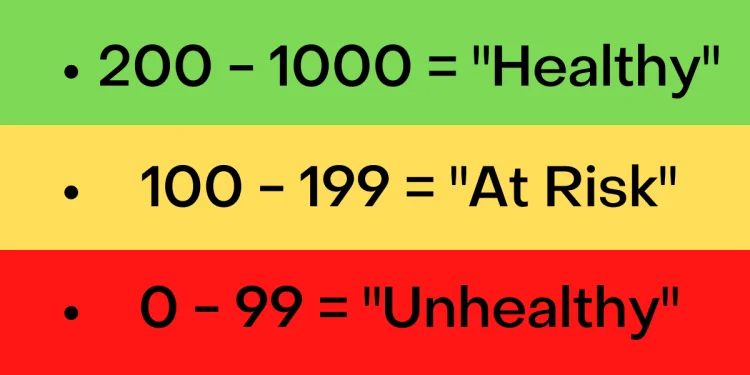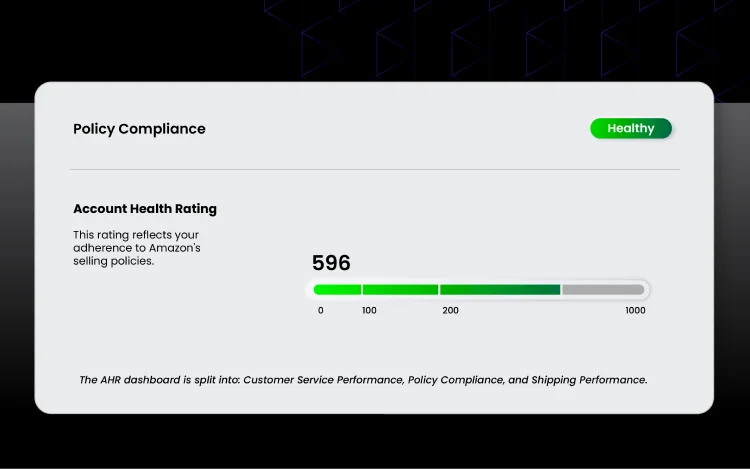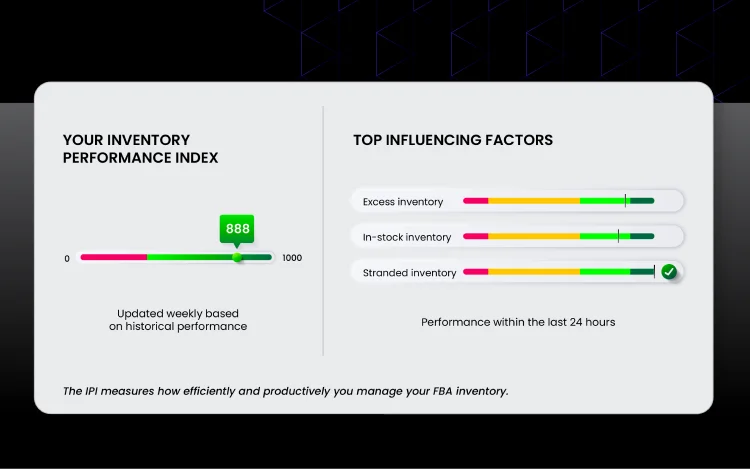One of the worst experiences for Amazon sellers is logging in to find out that your item has been removed or your account has been suspended. This shock is magnified when you don’t even know what you did wrong to receive such a harsh punishment. In response to sellers’ calls for transparency, Amazon has created the Account Health Rating (AHR).
This Amazon update offers sellers the insight they need to stay on the good side of policy. Keep on reading as we dive into the new color-coded rating and explain how to use it to your advantage.
What is the Account Health Rating?
Similar to the Inventory Performance Index (IPI), the AHR is a score that ranges from 0 to 1,000. The difference is that it shows the status of your account’s health, and there are only three levels:

Sellers with “Healthy” ratings are in good standing, and it’s comforting that the large majority of scores are in the “Healthy” range. If your AHR dips below that, you are “At Risk” of having your selling rights suspended. Sellers with “Unhealthy” accounts are very likely to become deactivated or already have been.
Although these consequences sound dire, there’s no need to stress. You’re following the same rules as before …
Will This Make Selling on Amazon More Difficult?
The short answer is no. AHR doesn’t add any new policies to follow. As Vanessa Hung, CEO of Online Seller Solutions, explains, this Amazon update provides:
- A holistic metric that will be the determining factor for account suspension based on accumulated policy violations
- A method for sellers to prioritize their issues due by seeing the severity of each violation
Keep in mind, though, that AHR doesn’t replace any policies either. Sellers are still responsible to follow all the current Amazon rules. The difference is that now you know which ones you may be violating, and which ones are the most dire. So let’s look at where your score comes from.
What Affects Your AHR Score?
The Account Health dashboard is split into three sections, each one with its own subset of policy-related criteria and thresholds to maintain. Scores are rated according to Customer Service Performance, Policy Compliance, and Shipping Performance.
Customer Service Performance
The main policy here is Order Defect Rate (ODR), which must be under 1% over the last 60 days. ODR derives from negative feedback, A-to-z Guarantee claims, and chargeback claims. Your goal should be to keep all of these metrics as close to 0 as possible, but keep in mind that Customer Service Performance is designed to be difficult to perfect, as Amazon highly values its customer service and has high standards for best-in-class support.
Product Policy Compliance

This section is the longest, and includes all of the violations or complaints that your listings might receive. This includes intellectual property, product authenticity, and product safety. You can review the full list of policies included in Account Health Rating on Amazon’s official website. The target for sellers is 0 issues across all policies, so addressing any that come up as soon as possible should be a top priority to avoid products getting delisted.
Unlike Customer Service, Product Policy Compliance is an easier metric to manage, as the different levels of severity and the amount of complaints received are usually proportional to the size of the account.
Shipping Performance
The categories and thresholds are are pretty simple:
- Late Shipment Rate – under 4%
- Pre-Fulfillment Cancel Rate – under 2.5%
- Valid Tracking Rate – over 95%
Note that due to inventory management, supply chain issues, and other stocking considerations, Shipping Performance can be a tricky metric to consistently ace on Amazon.
How to Improve Your AHR
In order to get a perfect score of 1,000 you need to consistently operate without any policy violations. If Amazon detects any infractions, your score will be lowered based on factors such as the number of currently unresolved policy violations, the severity of those violations, and the extent to which you positively impact the customer experience via your selling activities in general.
Improving your score usually is as simple as addressing those issues. Along with any violation notices, Amazon will provide details on how to solve the issue. Sellers who address those violations will see their scores improve in 24-48 hours.
One word of caution – the Account Health dashboard may take some time before it updates you on any violations. Sellers are advised to pay attention to performance notifications daily. Our recommendation is to use 24/7 monitoring software to receive instant alerts on listing suppressions, negative reviews, out-of-stock items, and more. You can customize your notifications, send them through your preferred communication platform (email, SMS, Slack, Jira), and receive daily reports at your discretion.
Repeat Offenses
While the process of recovering your lost AHR points is straightforward, Amazon expects sellers to learn from their mistakes. Any policy that gets violated multiple times reduces the AHR score by larger and larger amounts. More importantly, each policy has a maximum number of violations, which are not currently public. If you cross that limit, you may have a listing removed or a full account deactivation, despite having a “Healthy” rating.
What to Do If Your Selling Account Has Been Deactivated
For this more severe outcome, you must submit an appeal to have your account reinstated. This must include a formal plan of action that explains all the steps you will take to correct the issues on your account. Time is of the essence for appeals, so if this ever happens to you, start the appeals process immediately.
Is a “Healthy” AHR Good Enough?

Now that you know the ins and outs of the Account Health Rating, it should be a breeze to keep your score at or near 1,000. Don’t get too comfortable, though, because a “Healthy” account is a long way from an optimized account. AHR is a definite improvement in transparency, but top 1% sellers must utilize software to maximize their returns.
Your AHR doesn’t warn you for problems like ASIN redirects or missing seller information, but they also have a serious impact on your bottom line. This is why harnessing tools will keep you ahead of the game so you can solve problems before they become catastrophes.
Beyond that, there are other Amazon scores that matter, too. Your IPI score is also crucial to your continued success. Avoiding excess and stranded inventory, for example, will keep your FBA fees lower and your available warehouse space higher. While Amazon will give you a rating, they don’t offer any tools to solve their problems, which is why so many sellers turn to SoStocked for their inventory management. The hardest part of inventory management is forecasting; running out of inventory, or having too much, hurts your IPI score, which can result in serious FBA penalties. SoStocked does the hard work for you, turning forecasting into a handful of simple formulas.
Key Takeaways
Your Account Health Rating will let you know when you are at risk of having your listings removed or your account deactivated, and they will tell you the steps needed to get back on track. This is a definite step in the right direction, which was brought on by sellers’ demands for transparency when it comes to Amazon’s punitive actions.
Healthy accounts are not at risk of deactivation, except for particularly egregious offenses, and good scores will come as a natural consequence of operating your business according to Amazon’s established policies. Check out the full suite of Carbon6 tools to see how you can raise your account to a level of optimization that saves you time, energy, and money while leaping ahead in success.








